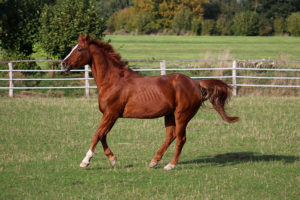Nutritional Strategies for Managing Horses With Insulin Dysregulation

Metabolic disorders are becoming more common in horses and, without proper care, can lead to endocrinopathic laminitis. Managing these conditions effectively can be challenging. For horse owners, understanding insulin dysregulation (ID) and implementing effective prevention and management strategies is critical for the long-term health of horses with ID.
What is Insulin Dysregulation in Horses?
Insulin dysregulation compromises the horse’s ability to metabolize soluble carbohydrates. The broad term that encompasses both tissue insulin resistance and elevated blood insulin (hyperinsulinemia). “Not all horses exhibit both conditions, though; some only have insulin resistance, while others may have elevated insulin levels after eating,” says Erica Macon, MS, PAS, PhD, an assistant professor at Texas A&M University, in College Station. “Either condition is a cause for concern in the development of endocrinopathic laminitis.”
When a healthy horse eats nonstructural carbohydrates (NSC, starch and sugar) the digestive enzymes in the gastrointestinal tract break them down into glucose. When blood glucose levels rise, the pancreas releases insulin, which helps the glucose move from the blood into tissues. This then reduces blood glucose levels, and the pancreas reduces insulin secretion in response.
“These horses tend to have some degree of insulin resistance, where insulin fails to do its normal job after a meal rich in NSCs of helping the absorbed glucose to get from the blood and into tissues like the muscle, to reduce blood glucose concentrations back to normal,” says Shannon Pratt-Phillips, MS, PhD, PAS, a professor in the Department of Animal Science at North Carolina State University, in Raleigh. “In these horses the pancreas releases very high amounts of insulin to try to deal with the glucose load and its (insulin’s) reduced effectiveness, but glucose concentrations fail to come back to normal as quickly as healthy horses. Horses with ID tend to also have elevated insulin concentrations even without a previous meal.”
Hyperinsulinemia has been shown to cause laminitis, a painful condition characterized by inflammation of the laminae (the tissue that connects the hoof wall to the underlying coffin bone) that potentially leads to separation and rotation of the coffin bone. In these cases it’s referred to as endocrinopathic laminitis.
Which Horses Are at Risk for ID?
Multiple risk factors can contribute to an equid developing ID. “There is both a genetic and environmental component,” says Macon. “Have you ever been asked during a doctor’s appointment if diabetes runs in your family? Equids experience a similar genetic predisposition to ID and obesity. For some equids their genetics simply aren’t in their favor. For example, Spanish breeds and most pony breeds are more prone to being overweight and developing ID.”
Horses with pituitary pars intermedia dysfunction (PPID, formerly equine Cushing’s disease) are more likely to develop ID. Researchers are still working to fully understand this connection, says Macon.
Although obesity and disorders such as PPID are primary risk factors, horses that do not match that description can also have metabolic problems. “It is possible for a horse to be ID and be lean, or an obese horse to have normal glucose and insulin responses to a simple carbohydrate meal,” says Pratt-Phillips. “Horses that are fed high amounts of NSCs on a regular basis may also have lower insulin sensitivity.”
Even if your horse does not match the usual “at-risk” description, it is important for him to maintain a healthy body condition to reduce his risk of developing metabolic problems. Your horse should not exceed a body condition of 6 on the Henneke nine-point system. “You should always be able to feel a horse’s ribs,” says Pratt-Phillips.
Feeding Horses With ID
If your veterinarian diagnoses your horse with ID, consider a few key aspects of his management. If the animal is obese, work with an equine nutritionist to adjust his diet for weight loss. However, if he has been diagnosed with PPID, work closely with your veterinarian to medically manage him as well.
Regardless of the underlying cause, horses with ID should eat a diet low in NSCs, which you can calculate based on the feed label. “I use NSC (water-soluble carbohydrates plus starch) because it includes fructans,” says Macon. “Now, not every horse responds to fructans, but some horses do, so I like to err on the side of caution.”
The percentage of NSCs in the diet is often a driving factor for horse owners in determining if a forage or concentrate is going to be safe for their ID horse, but the industry is moving away from relying on a percentage.
“When we think about a percentage, we don’t take into consideration where that starch is coming from or how bioavailable it is, so breaking down the actual load on a grams per kilogram body weight (BW) seems to be the better option,” says Macon. “Up until my work, there wasn’t any NSC threshold studies done in metabolic horses.” Researchers have now found 0.1 grams of NSC per kilogram of body weight per meal to be the safe threshold for metabolic horses.
Therefore, when designing your horse’s feeding plan, find the percentage of NSC in the feed, the amount of that feed your horse receives at each meal, and your horse’s body weight. Use the below calculation to ensure you do not exceed 0.1 g NSC per kg BW per meal.
Calculating NSCs in Your Horse’s Meal
Information Needed
- Horse’s ideal BW
- NSC % of commercial grain
- Feeding rate for horse’s ideal BW based on manufacturer’s instructions
Calculation
- Convert horse’s weight to kilograms.
- Convert total feeding rate to grams.
- Ensure NSC % is on a dry matter basis. Pelleted concentrates are 95% dry matter. Textured concentrates are 90% dry matter.
- Multiply the NSC on a dry matter basis and the feeding rate in kilograms.
- Divide the grams of NSC in the concentrate by the animal’s BW in kilograms.
Example Calculation
Horse’s body weight = 500 kg
Feeding rate of concentrate = 1,800 g
NSC % = 12% on a dry matter basis
(0.12 NSC dry matter basis) x (1,800 g) = 216 g NSC in the concentrate fed daily
216 g NSC / 500 kg = 0.43 g NSC provided in the concentrate daily
“If your horse’s meal is too high in NSCs, you can split the feeding into more meals per day so that each one is smaller and will have less glucose,” says Pratt-Phillips.
When choosing your horse’s forage, consider both the NSC content of the hay and the time the horse takes to consume it after each feeding. While less research exists in this area, the current recommendation involves providing low-NSC hay (below 10% on a dry matter basis) and encourages prolonged feeding time. “Implementing slow-feeding strategies to make sure that the horse is having a smaller quantity over a longer period of time I think is the safest bet that we can go with right now versus throwing two flakes on the ground and letting them consume it rapidly,” says Macon.
Take-Home Message
Our scientific understanding of equine metabolic problems constantly expands. Understanding ID and which horses are at risk will help you recognize issues with your horse’s metabolic health and seek veterinary intervention. Prevention is also important, keeping horses lean and avoiding obesity to reduce their risk of developing ID. New calculations for determining the NSC content of your horse’s meals can help you accurately determine if his diet is safe for his metabolic health.

Related Articles
Stay on top of the most recent Horse Health news with


















